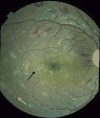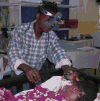Malarial retinopathy: a newly established diagnostic sign in severe malaria
- PMID: 17123967
- PMCID: PMC2367432
Malarial retinopathy: a newly established diagnostic sign in severe malaria
Abstract
Severe malaria is commonly misdiagnosed in Africa, leading to a failure to treat other life-threatening illnesses. In malaria-endemic areas, parasitemia does not ensure a diagnosis of severe malaria because parasitemia can be incidental to other concurrent disease. The detection of malarial retinopathy is a candidate diagnostic test for cerebral malaria. Malarial retinopathy consists of a set of retinal abnormalities that is unique to severe malaria and common in children with cerebral malaria. Its presence and severity are related to risk of death and length of coma in survivors. A large, prospective autopsy study of children dying with cerebral malaria in Malawi found that malarial retinopathy was better than any other clinical or laboratory feature in distinguishing malarial from non-malarial coma. However, visualization has to date relied on specialist examination techniques. Further studies are planned to evaluate the usefulness of funduscopy by general clinicians in a variety of settings across Africa. Studies of the retina and retinal blood vessels provide an unparalleled opportunity to visualize an infected microvasculature and its effect on neural tissue in vivo. This report reviews current knowledge of malarial retinopathy, including its use as a diagnostic test in the comatose child, and its value as a tool for research into the pathophysiology of cerebral malaria.
Figures







Comment in
-
Role of folate deficiency in the pathogenesis of retinal and cerebral hemorrhages in cerebral malaria.Am J Trop Med Hyg. 2007 May;76(5):793; author reply 793-4. Am J Trop Med Hyg. 2007. PMID: 17488892 No abstract available.
References
-
- World Health Organization. Severe falciparum malaria. Trans R Soc Trop Med Hyg. 2000;94:S1–S90. - PubMed
-
- Smith T, Charlwood JD, Kihonda J, Mwankusye S, Billingsley P, Meuwissen J, Lyimo E, Takken W, Teuscher T, Tanner M. Absence of seasonal variation in malaria parasitaemia in an area of intense seasonal transmission. Acta Trop. 1993;54:55–72. - PubMed
-
- Kallander K, Nsungwa-Sabiiti J, Peterson S. Symptom overlap for malaria and pneumonia–policy implications for home management strategies. Acta Trop. 2004;90:211–214. - PubMed
Publication types
MeSH terms
Grants and funding
LinkOut - more resources
Full Text Sources
Medical
